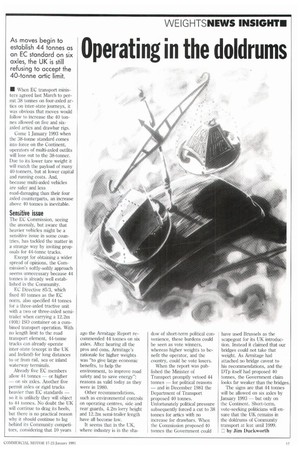Operating in the doldrums
Page 25

If you've noticed an error in this article please click here to report it so we can fix it.
As moves begin to establish 44 tonnes as an EC standard on six axles, the UK is still refusing to accept the 40-tonne artic limit.
• When EC transport ministers agreed last March to permit 38 tonnes on four-axled artics on inter-state journeys, it was obvious that moves would follow to increase the 40 tonnes allowed on five and sixaxled artics and drawbar rigs.
Come 1 January 1993 when the 38-tonne standard comes into force on the Continent, operators of multi-axled outfits will lose out to the 38-tonner. Due to its lower tare weight it will match the payload of many 40-tonners, but at lower capital and running costs. And, because multi-axled vehicles are safer and less road-damaging than their four axled counterparts, an increase above 40 tonnes is inevitable.
Sensitive issue
The EC Commission, seeing the anomaly, but aware that heavier vehicles might be a sensitive issue in some countries, has tackled the matter in a strange way by inviting proposals for 44-tonne trucks.
Except for obtaining a wider spread of opinions, the Commission's softly-softly approach seems unnecessary because 44 tonnes is already well established in the Community.
EC Directive 85/3, which fixed 40 tonnes as the EC norm, also specified 44 tonnes for a three-wded tractive unit with a two or three-axled semitrailer when carrying a 12.2m (401t) ISO container on a combined transport operation. With no length limit to the road transport element, 44-tonne trucks can already operate inter-state (except in the UK and Ireland) for long distances to or from rail, sea or inland waterway terminals.
Already five EC members allow 44 tonnes — or higher — on six axles. Another five permit axles or rigid trucks heavier than EC standards — so it is unlikely they will object to 44 tonnes. No doubt the UK will continue to drag its heels, but there is no practical reason why it should continue to lag behind its Community competitors, considering that 10 years ago the Armitage Report recommended 44 tonnes on six axles. After hearing all the pros and cons, Armitage's rationale for higher weights was "to give large economic benefits, to help the environment, to improve road safety and to save energy": reasons as valid today as they were in 1980.
Other recommendations, such as environmental controls on operating centres, side and rear guards, 4.2m lorry height and 12.2m semi-trailer length have all become law.
It seems that in the UK, where industry is in the sha dow of short-term political convenience, these burdens could be seen as vote winners, whereas higher weights to benefit the operator, and the country, could be vote losers.
When the report was published the Minister of Transport promptly vetoed 44 tonnes — for political reasons — and in December 1981 the Department of Transport proposed 40 tonnes. Unfortunately political pressure subsequently forced a cut to 38 tonnes for artics with no increase for drawbars. When the Commission proposed 40 tonnes the Government could
have used Brussels as the scapegoat for its UK introduction. Instead it claimed that our bridges could not take that weight. As Armitage had attached no bridge caveat to his recommendations, and the DTp itself had proposed 40 tonnes, the Government claim looks far weaker than the bridges.
The signs are that 44 tonnes will be allowed on six axles by January 1993 — but only on the Continent. Short-term, vote-seeking politicians will ensure that the UK remains in the doldrums of Community transport at leat until 1999. .7_ by Jim Duckworth
















































































